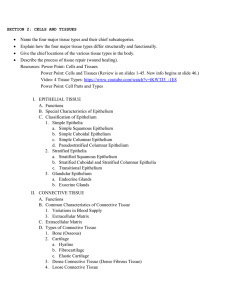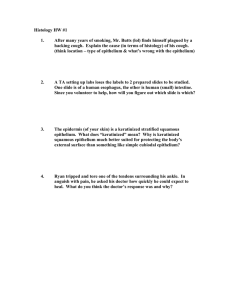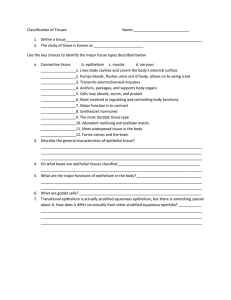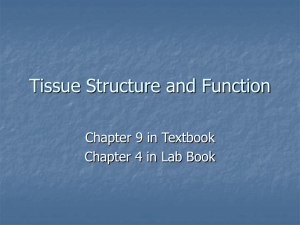Lectures 3 & 4 Histology: The Study of Tissues 4-1
advertisement
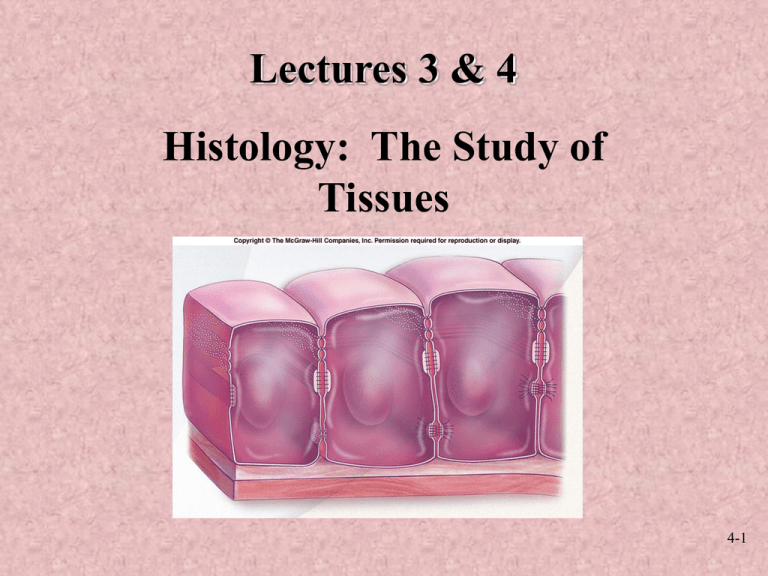
Lectures 3 & 4 Histology: The Study of Tissues 4-1 Tissues and Histology • What is a Tissue? – A collection of similar cells and noncellular substances (extracellular matrix) secreted by the cells • Tissue Level of Organization – – – – Epithelial Connective Muscle Nervous • Histology: Microscopic Study of Tissues 4-2 Epithelium Characteristics Fig. 4.1 1. Consists almost entirely of cells 2. Covers body surfaces and forms glands 3. Has free and basal surface 4. Avascular 5. Undergoes mitosis 4-3 Classification of Epithelium: How to Make Sense of It All? There are 2 basic features (or criteria) for classification of epithelium: 1. Number of cell layers • • Simple – Single layer Stratified – More than 1 layer Exceptions? • • Pseudostratified – Single layer; only some cells reach free surface Transitional – Number of cell layers decreases as it is stretched Fig. 4.2 4-4 Classification of Epithelium 2. Shape of cells • Squamous (=scaly) – • Cells flattened Cuboidal – • Cells cube-shaped Columnar – Cells are taller than wide Fig. 4.2 4-5 Types of Epithelium • Name of epithelium is combination of: number of cell layers and shape of cell (Table 4.2) • 3 types of simple: simple squamous epithelium, simple cuboidal epithelium and simple columnar epithelium • 3 types of stratified: stratified squamous epithelium, stratified cuboidal epithelium and stratified columnar epithelium • Pseudostratified columnar epithelium • + Transitional epithelium: Cuboidal to columnar when not stretched and squamous-like when stretched 4-6 Review Question Which of the following statements about epithelial tissue is correct? (a) All cells of pseudostratified columnar epithelial tissue have a free surface. (b) You would predict simple squamous epithelium lining the inside of an organ that absorbs substances. (c) Transitional epithelium has multiple layers of cells that can change shape. (d) The epithelium of your skin is a simple squamous epithelium. (e) Cuboidal or columnar cell shapes are optimal for diffusion. 4-7 Glands • • Secretory organs made mostly of epithelium Form as invaginations (ingrowths) of outer layer of epithelium in embryo • Two basic types: 1. Exocrine: – Have ducts lined with epithelium 2. Endocrine – Have no ducts – Examples include pituitary gland, pancreas, thyroid gland Fig. 4.4 4-8 Connective Tissue • Abundant and diverse • Consists of cells separated by extracellular matrix • Specialized cells produce the extracellular matrix – Suffixes • -blasts: create the matrix • -cytes: maintain the matrix • -clasts: break the matrix down for remodeling • Performs variety of important functions 4-9 Connective Tissue Categories • Embryonic or mesenchyme • Adult – Loose – Areolar – Adipose – Dense – Cartilage – Bone – Blood Table 4.6 4-10 Loose Connective Tissue Table 4.9 Areolar tissue • Loose packing material of most organs and tissues • Attaches skin to underlying tissues • Contains collagen, reticular, elastic fibers and variety of cells 4-11 Loose Connective Tissue Adipose Tissue • Consists of adipocytes – Types • Yellow (white) – most abundant, white at birth and yellows with age • Brown – found only in specific areas of body as axillae, neck and near kidneys Table 4.9 4-12 Dense Regular Connective Tissue Has abundant collagen fibers • Tendons: Connect muscles to bones • Ligaments: Connect bones to bones Table 4.10 4-13 Dense Irregular Connective Tissue • Forms most of dermis of the skin Table 4.10 4-14 Elastic Connective Tissue • Ligaments in vocal folds • In walls of elastic arteries Table 4.10 4-15 Review Question In which of the following locations would you expect to find dense irregular connective tissue? (a) Nuchal ligament (b) Dermis of skin (c) Vocal cords (d) Large arteries (e) Tendon 4-16 Points to Remember • Two basic components to a tissue: – Similar cells specialized for a function – Non-cellular matrix secreted by the cells • Epithelial tissue is typically a covering or lining • Connective tissue is diverse and extremely abundant 4-17 Questions? 4-18

